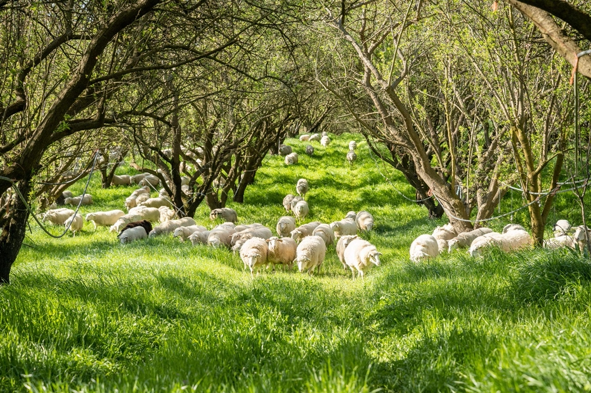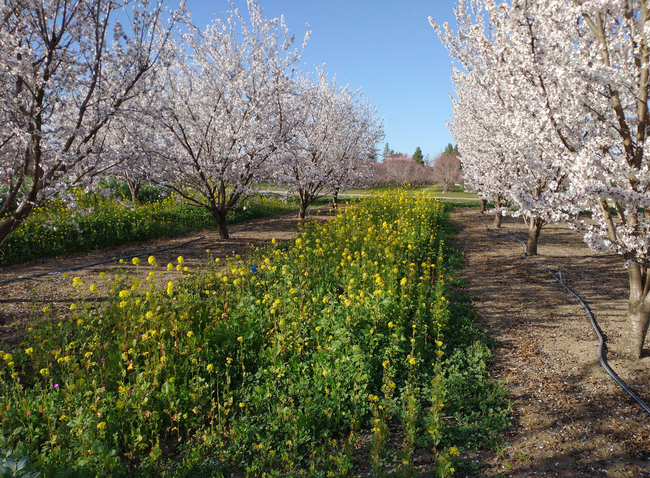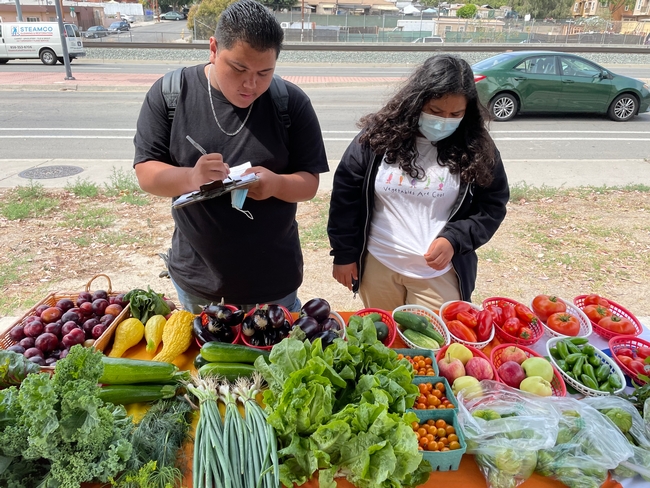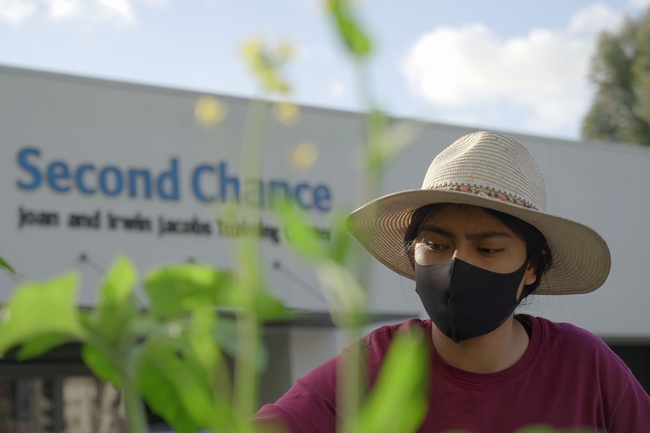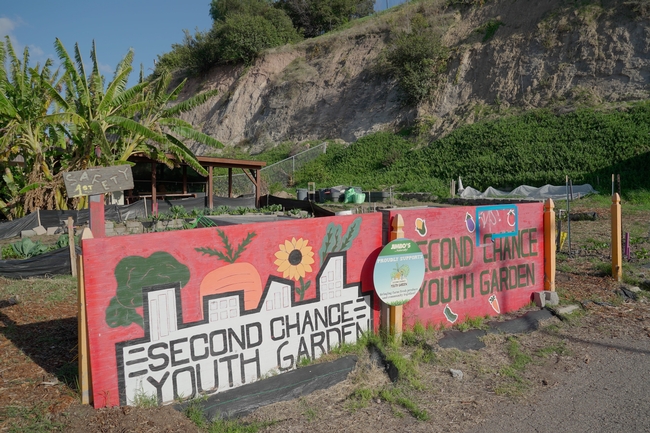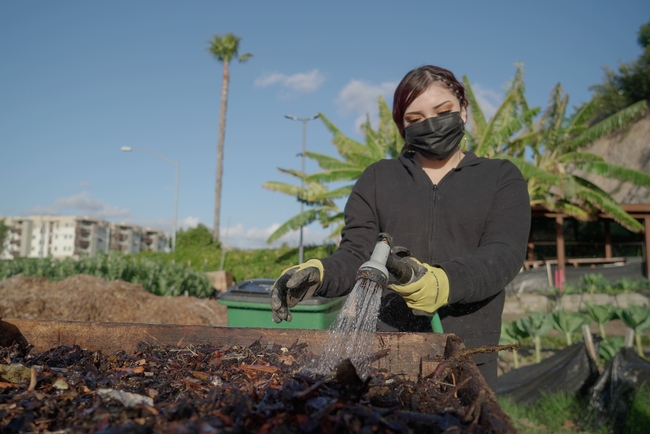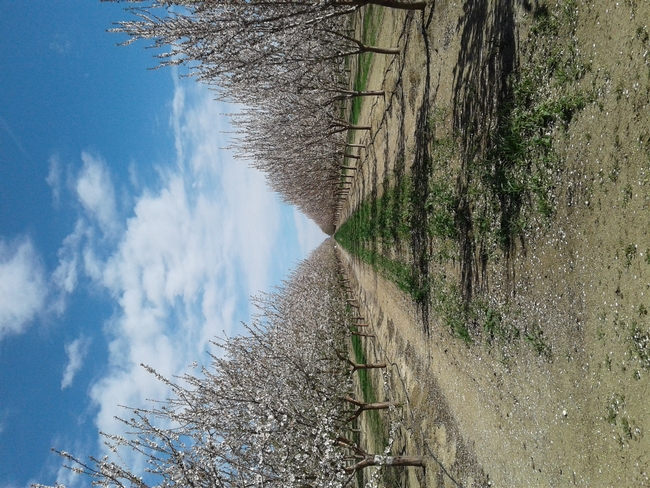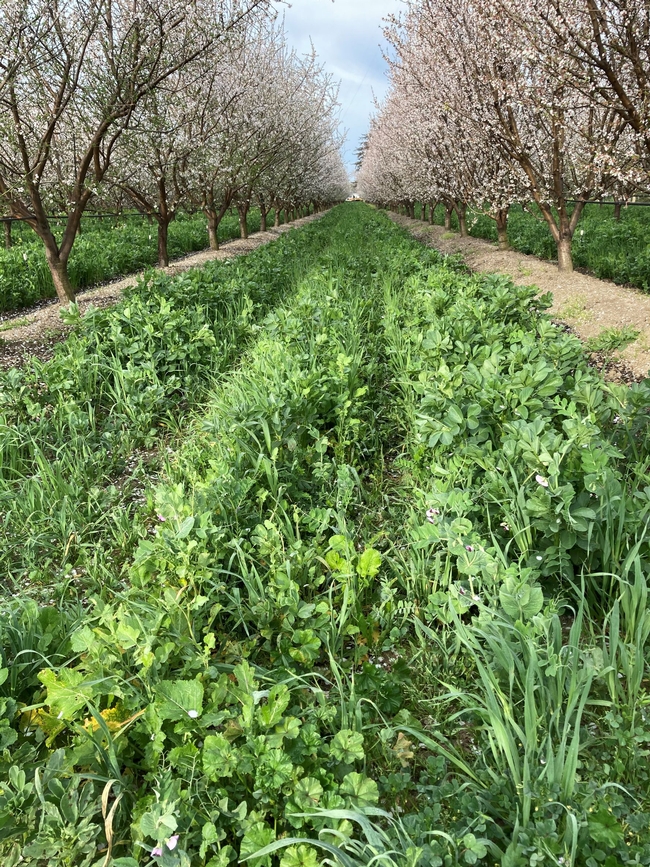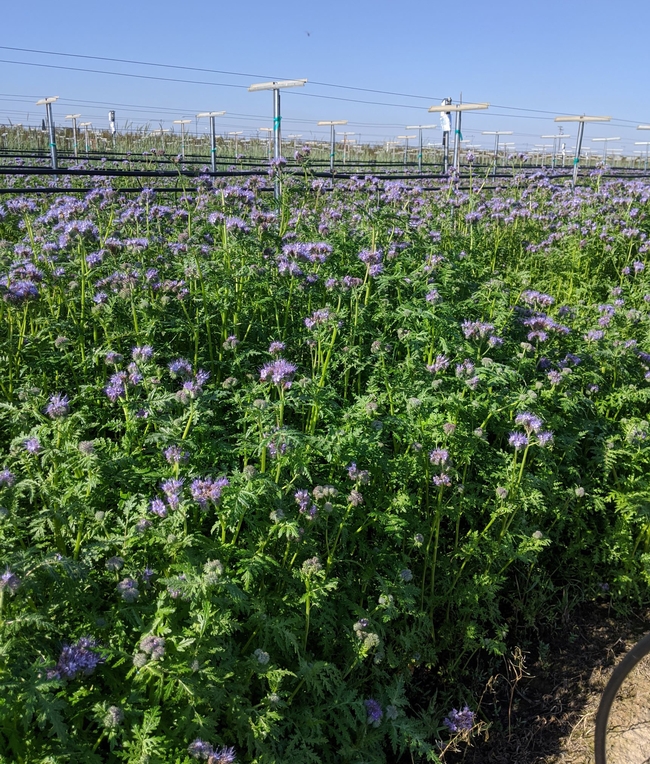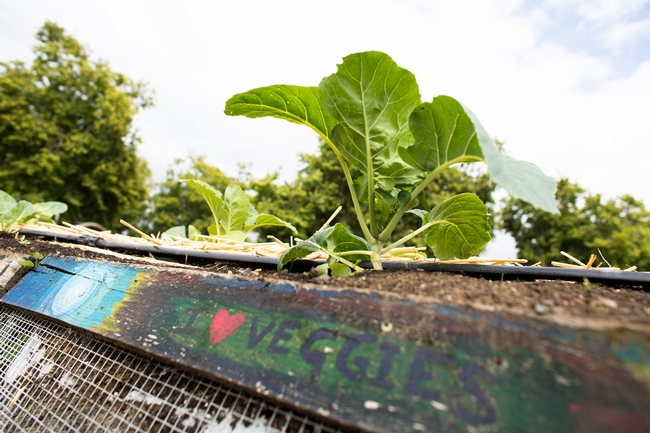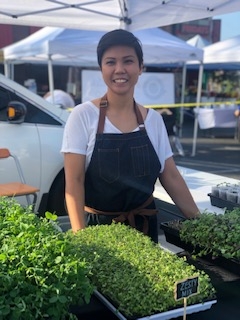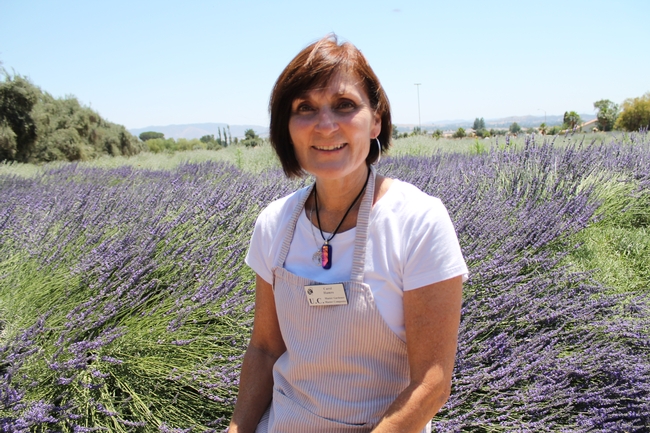Posts Tagged: Sustainable Agriculture Research and Education Program
Growers invited to see benefits of cover crops in orchards, vineyards
Searchable database of growers experienced in growing cover crops launched
Growers are invited to tour orchards and vineyards and hear from other growers about their experiences with cover crops.
UC Sustainable Agriculture Research and Education Program, UC Cooperative Extension, the Napa Resource Conservation District, and the Community Alliance with Family Farmers have created a searchable database of orchard and vineyard growers experienced in growing cover crops that will help other growers bring the benefits of the practice to their operations.
“The tours are part of a project for which we recently unveiled new tools for orchard and vineyard growers to learn about cover cropping from experienced growers,” said Sonja Brodt, associate director of the UC Sustainable Agriculture Research and Education Program.
The database describes cover cropping strategies, details of field practices, benefits and challenges experienced by cover crop growers in orchards and vineyards in the southern Sacramento Valley (including the Capay Valley) and the North Coast viticulture region. The cover crop grower database is available at https://sarep.ucdavis.edu/covercropsdb.
Feb. 8, 1-5 p.m., Capay Valley tour:
The tour will visit three organic farms in the Capay Valley that are integrating cover crops and grazing in their orchard and vineyard systems. Topics of discussion will include:
- Strategies for integrating cover crops into orchards and vineyards
- Impacts of cover cropping and grazing on soil health
- Funding and information resources for growing cover crops
Speakers will include:
- Rory Crowley, Director of Habitat Programs, Project Apis m.
- Amélie Gaudin, Associate Professor, Department of Plant Sciences, UC Davis, Endowed Chair in Agroecology
- Hope Zabronsky, Climate-Smart Agriculture Program lead, UC Agriculture and Natural Resources
To register for the Feb. 8 tour, visit https://sarep.ucdavis.edu/events/grazing-cover-crops-orchards-and-vineyards-capay-valley-tour.
March 8, 1-4 p.m., Arbuckle area tour:
The tour will visit two conventional farms in the Arbuckle area that are integrating cover crops into their orchard and vineyard systems.
Topics of discussion will include:
- Strategies for integrating cover crops into orchards and vineyards
- Impacts of cover cropping on soil and water balance
- Frost risk protection and prevention
- Funding resources for growing cover crops
Speakers will include:
- Rory Crowley, Director of Habitat Programs, Project Apis m.
- Kosana Suvocarev, UC Cooperative Extension Specialist in Biometeorology, UC Davis Department of Land, Air, and Water Resources
- Hope Zabronsky, Climate-Smart Agriculture Program lead, UC Agriculture and Natural Resources
To register for the March 8 tour, visit https://sarep.ucdavis.edu/events/cover-cropping-conventional-orchards-and-vineyards-arbuckle-area-tour
Youth-run garden provides 10,000 pounds of produce for San Diego families
UC SAREP's Sustainable Agriculture and Food Systems grant helps support Second Chance garden
Fifteen-year-old Xavier knows the anger within him will never leave. “I can't ever get rid of it,” he said.
“I've always wanted to just fight for no reason; I just had an anger issue, losing my temper quick with people,” added Xavier, a ninth-grader in San Diego County. “I have high expectations of myself.”
Xavier is working to keep his emotions under control, and he has found a sense of calm through his volunteer work. He was an intern – and then a peer supervisor – in the youth-run garden of Second Chance, a San Diego-based organization that works to break the cycles of poverty and incarceration by providing housing and job training to adults and young people.
Operating their garden as a small farm business, youth in the program, ages 14 to 21, offer produce to the community through their farm stand and a CSA (Community Supported Agriculture) model.
“The project incorporates a ‘farm to fork' approach in which youth not only experience how to grow food, but how to cook and eat healthfully,” said Gail Feenstra, director of the University of California Sustainable Agriculture Research and Education Program, which has a grant program that funds research and education projects – such as the youth garden – supporting sustainable food systems.
“Second Chance works primarily with youth in communities of color, providing them with training and also helping them develop confidence in themselves,” Feenstra said.
Filling a critical need for fresh produce
Caelli Wright, program manager of the Second Chance youth garden, said that grant funds from SAREP – a program of UC Agriculture and Natural Resources – have been used to purchase the supplies needed to sustain the program. The garden has filled a critical need for produce during the COVID-19 pandemic.
“After the pandemic hit, we recognized the increased need for fresh food in our neighborhoods,” Wright said. “That need was already there – southeast San Diego is considered a ‘food swamp' or ‘food apartheid', if you will – and with the onset of COVID, that need just escalated with unemployment and complications in our food production systems.”
Through a partnership with UC San Diego Center for Community Health and Encanto Elementary School (located down the block from the garden), donations enabled the program to give its CSA shares to about 25 families at Encanto. Over the course of the pandemic, the youth have grown 10,000 pounds of produce to donate.
At the same time, the program helps the young participants grow. For Xavier, being outdoors with peers empowered him to develop positive relationships. Previously, as a student in a charter school program, he was not accustomed to interacting with people and groups. Volunteering in the youth garden has given him a fresh perspective and understanding of others.
“Learning to be patient with people and [to] accept sometimes that if I don't know something, I need to ask about it, because I used to be so in my ego that I thought I knew everything,” Xavier explained. “But I don't know everything – I just learned to accept some things…that's just being part of life. And that's something that the garden has helped me with, personally.”
Opportunities for personal, social growth
Developing – and redeveloping – social skills are especially important for students, as they return from the disconnections associated with remote learning.
“Right now, with a lot of students facing the aftermath of COVID and being restricted to learning at home and not getting as much social interaction in their daily lives, it's led to a lot of challenges, mental health-wise, and social and emotional learning-wise,” Wright said. “The garden program provides that opportunity that some youth have been missing out on.”
In southeast San Diego, such crucial opportunities for personal growth and career exploration are harder to come by, and Second Chance started the garden in 2012 to give youth a unique work experience and valuable skills. About 400 young people have participated in the program.
“The youth that we serve are coming from low-income neighborhoods that are underserved with resources,” Wright said. “They just are not exposed to the same opportunities [as those in higher-income areas] to build skills or be ready for the workforce or to reach higher education – so that's where our program comes in and helps deliver those needed services.”
Xavier, who originally came to the garden because he heard that landscaping could be a lucrative career, recently finished his second stint as a peer supervisor in the youth garden. With his new skills, he and his cousin are looking to start a business of their own, cutting grass and doing yardwork in their community.
And, late last month, Xavier transferred to a more traditional high school environment.
“Being in a charter school after two, three years,” he said, “I've realized I miss being around more people.”
Can California native plants be used as cover crops to benefit farmers and native ecosystems?
In late February, in an almond orchard in the Sacramento Valley, the fall-planted cover crop mix of grasses, brassicas and legumes had barely produced a green fuzz above the soil surface, and it was unclear when it would bloom. Unfortunately, this scene is becoming more frequent across California, as climate change causes more prolonged droughts and rain-dependent winter cover crops can barely grow, which delays or reduces bloom, essential for supporting pollinators. Fortunately, California native plant species have evolved with drought and have developed many strategies to survive and reproduce in those conditions.
Would it be possible to capitalize on the over 9 million acres of cropland in California for drought resilience and habitat restoration by utilizing more native species as cover crops? Our team at the UC Sustainable Agriculture Research and Education Program (UC SAREP) spent some time considering various native plant species and their potential ecological and operational attributes as cover crops. For a full list of species and their attributes, see https://ucanr.edu/sites/covercrops/.
Many native species are so well adapted to drought that they will still germinate and bloom during extremely dry years, for example, annuals like Tidy Tips (Layia platyglossa) and California poppy (Eschscholzia californica). Alternatively, perennial bulb species like Prettyface (Triteleia ixioides) and Bluedicks (Dipteronstemon capitatus) become dormant during the dry summer, retaining their bulbs below ground and re-growing when the rains return. These species could perhaps fit well in no-till orchard systems. Summer dormancy is important for tree nut growers because they usually need clean ground under the trees during harvest. Moreover, the costs to terminate and reseed would potentially be eliminated. While these species are well-known by Native Americans for their edible bulbs, at this point in time, we are not aware of any cover cropping trials having ever been conducted with these species.
Another species with strong reseeding and more availability is the annual Lacy Phacelia (Phacelia tanacetifolia), which offers an intriguing historical precedent for developing a native species for cover cropping purposes. Native to California, it was introduced into Europe in 1832 by Germans. It is very attractive to pollinators and experienced a boom there in the early 1990s. European beekeepers and farmers have been using Lacy Phacelia as a cover crop ever since, and it has recently been gaining traction on California farms as well. California has many species of phacelia, with another, described as being even more attractive to native bees, being the annual Great Valley Phacelia (Phacelia ciliata). Besides supporting native bees, other native plant species can contribute nitrogen to the soil, such as annual Lupine (Lupinus spp.) and perennial Deerweed (Acmispon glaber), which are legumes and form an association with nitrogen-fixing bacteria in their roots.
Cover crops are not usually considered marketable crops. However, we should not preclude the potential for some plants that are useful as cover crops to provide a harvestable product as well. Native perennial fiber plants such as Indian hemp dogbane (Apocynum cannabinum), narrow leaf milkweed (Asclepsias fascicularis), and common nettle (Urtica dioica) could offer the opportunity to cultivate summer cover crops that have a market value, especially in cases where farmers are already willing to irrigate their cover crops to improve their development and amplify the benefits. Bowles Farming in the San Joaquin Valley is experimenting with growing these three species for fiber production. All three also attract native bees and important butterfly species such as monarchs (as long as farmers avoid spraying insecticides).
While we believe that some native species could open new opportunities for farmers as cover crops, we still have insufficient studies testing the effects and viability of these species. Organizations like the NRCS Plant Materials Center at Lockeford and the Xerces Society are conducting practical studies with native species, creating plant guides and working with farmers to expand their use. In addition, researchers Lauren Hale of the USDA Agricultural Research Service and Anil Shrestha of California State University, Fresno, are using a 2021 UC SAREP small grant to study the effects of native species mixes on water demand and weed populations in San Joaquin Valley grape vineyards. Hale suggests that below-ground ecosystems may benefit as much from native plants as above-ground ecosystems. Says Hale, “Because plants and their microbiomes have evolved together for millennia, it seems logical that native plants would promote a good response from the native soil microbiota.”
For additional information:
UC SAREP List of California Native Species for Potential Use as Cover Crops: https://ucanr.edu/sites/covercrops/
Xerces Society lists of pollinator-friendly native species for California: https://xerces.org/pollinator-resource-center/california
NRCS California Plant Materials Center plant guides: https://www.nrcs.usda.gov/wps/portal/nrcs/publications/plantmaterials/pmc/west/capmc/pub/
UC SAREP Cover Crops Database: https://sarep.ucdavis.edu/covercrop
UC SAREP awards grants for sustainable food-systems research and outreach
The University of California Sustainable Agriculture Research & Education Program — a statewide program of UC Agriculture and Natural Resources — announced the recipients of its 2021 Sustainable Agriculture and Food Systems Small Grants Program today (April 13, 2021).
The grants program, which was reinstated this year after a 10-year hiatus, supports pilot projects focusing on strengthening California's sustainable agriculture and food systems. Together, 11 recipients are receiving $77,000 in funding to support their work.
"Many groups have innovative ideas on how to build a more profitable, environmentally sustainable and just food system in California, but they often need seed funding to get those ideas off the ground,” said Glenda Humiston, University of California vice president for agriculture and natural resources. “That's what UC ANR and UC SAREP are bringing to the table with these small grants: an opportunity to bring a creative idea to fruition."
The recipients of this year's grants are:
Agricultural and Land-Based Training Association, to pilot an agricultural plastics recycling program among primarily Spanish-speaking small-scale producers. (Project lead: Nathan Harkleroad)
California State University, Fresno, to evaluate the effect of cover crops on water demands and weeds in table grape vineyards in the Eastern San Joaquin Valley. (Project lead: Anil Shrestha)
Napa Farmers Market, to communicate the importance of locally and sustainably grown produce from farmers of diverse backgrounds through a bilingual educational campaign. (Project lead: Cara Wooledge)
Red Bluff Joint Union High School District, to teach high school students environmentally regenerative agriculture and leadership skills through its School Garden to Cafeteria project. (Project lead: Marissa Stevens)
San Diego Second Chance Program, to offer classes and workshops on sustainable agriculture for low- to middle-income youth with prior involvement in the juvenile justice system. (Project lead: Caelli Wright)
Santa Rosa Junior College, to add hibiscus products and mutual-aid garden kits to a bilingual mobile herb clinic that offers culturally relevant holistic health programs to Latinx and Indigenous populations. (Project lead: Heidi Hermann)
UC Agriculture and Natural Resources, to study the effects of livestock guardian dogs on wildlife species and the potential for conflict with recreationists. (Project lead: Carolyn Whitesell)
UC Cooperative Extension in Fresno County, to develop an equipment share program for equipment needed to apply compost on small-scale, diversified vegetable farms operated by socially disadvantaged farmers in Fresno County. (Project lead: Ruth Dahlquist-Willard)
UC Cooperative Extension in San Bernardino County, to provide interactive nutrition education classes, gardening lessons, and food safety and preservation demonstrations for ethnically diverse and limited-resource residents in San Bernardino County. (Project lead: Christine Davidson)
UC Davis, to build a team of researchers and community groups to develop a research and extension program to support beginning and first-generation ranchers in building resilience to environmental, economic, and social shocks and stressors. (Project lead: Leslie Roche)
UC Santa Cruz, to translate instructional videos on organic growing skills and practices into Spanish and to pilot a short course with Spanish-speaking trainees. (Project lead: Stacy Philpott)
“We're excited to watch these projects unfold over the coming year,” said Gail Feenstra, director of UC SAREP.
“This grant program isn't just important for supporting new ideas. It's also an opportunity for the University of California to build stronger connections with producers and other food system stakeholders across California. Those connections are essential for making the research and education that comes out of the university benefit everyone.”
UC SAREP was established in 1986 to strengthen California's agricultural production and supply chains to advance knowledge of the science of sustainability, support farmers and ranchers to develop more sustainable farming practices and assist communities to build healthy regional food systems.
Small-scale growers meet virtually to discuss organic agriculture
Over 150 current and prospective organic growers gleaned practical information shared by UC Agriculture and Natural Resources experts at the “Introduction to Small-Scale Organic Agriculture” workshop held virtually on Dec. 15, 2020. While most attendees were from inland San Bernardino, Riverside, Los Angeles and Orange counties, a handful were
from other continents, including growers from Bangladesh and Sri Lanka who stayed connected into the wee hours of their morning.“I attended this workshop and it was very helpful to hear different aspects of organic farming from experienced people,” one attendee from Sri Lanka said in an email.
UC Sustainable Agriculture Research and Education Program (SAREP) Director Gail Feenstra and Deputy Director Sonja Brodt kicked off the day with a presentation on program goals and resources. SAREP supports the goals of growers by developing more sustainable agricultural practices and effective regional food systems. They described a new online self-directed training program for organic specialty crop farmers in California and those in transition at https://ofrf.org/beginning-farmer-training-program. They also discussed marketing and business management.
Houston Wilson, director of UC ANR's new Organic Agriculture Institute, provided an overview of the program and pointed out that organic farming is expanding throughout California and includes more than 360 commodities. UC ANR will continue to take a lead role in developing and extending research and extension to this important sector, he said.
UC Cooperative Extension sustainable food systems advisor Rachel Surls discussed legal basics such as permits, licenses and regulations. UC Cooperative Extension organic agriculture specialist Joji Muramoto talked about the importance of soil health, a very popular and important topic. Other UC Cooperative Extension presenters covered nitrogen management (small farms advisor Margaret Lloyd), irrigation management (irrigation specialist Amir Haghverdi), integrated pest management (IPM advisor Cheryl Wilen), and plant diseases (plant pathology specialist Alex Putman).
“Thank you for the great workshop and resource links you provided for workshop materials and beyond! I have already downloaded and started to incorporate information from a few of the UC ANR pest management guidelines and legal and marketing links,” wrote an attendee from Chino. “Tips from peers are always great, too.”
During the afternoon portion of the workshop, five California organic farmers shared tips from their experiences. Carol Hamre (123 Farm, Cherry Valley) spoke about her trials and successes regarding vertebrate pest control and drip irrigation. Grace Legaspi (Tiny Leaf Micro Farm, Temescal Valley) talked about the art and science of growing microgreens. Lisa Wright (RD Flavorfull Farm, Riverside) discussed the importance of planting the right varieties in the right seasons. Arthur Levine (Huerta del Valle, Ontario) stressed the importance of collaboration and working synergistically as a team, and the importance of inclusiveness in all practices. Richard Zapien (‘R Farm, UC Riverside) shared inspiring stories and opportunities regarding the popular and successful UC Riverside community garden he manages.
“I am very glad to attend this workshop as a Bangladeshi,” wrote a grateful attendee from half way around the world. “Really, I have learned many things about organic farming in this workshop. I am working in the Tree nuts sector in Bangladesh but I have only cashew nuts plantation and processing factory…. I want to make an organic farm on 25 acres of land to cultivate vegetables, fruits, livestock, and fishing. Thanks again.”
Following the workshop, an extensive list of UCANR and external resources on topics covered during the workshop was provided to attendees https://ucanr.edu/sites/smallscalefarming/RESOURCES_/.
“I wanted to thank you for such a great webinar,” replied another Southern California participant. “I am a farm business advisor with the non-profit Kitchen Table Advisors and I learned a lot myself. Thank you for providing this list of resources. I look forward to the webinar recordings and slides, which I hope to be able to share with some of my farmer clients.”
The efforts of our co-sponsors also led to the overall success of the workshop. Inland Empire Resource Conservation District (IERCD) Manager Mandy Parkes, co-moderator, discussed district irrigation and soil testing resources and handed out gift certificates throughout the day. Evelyn Hurtado from IERCD volunteered to translate the workshop recordings into Spanish and Maggie O'Neill shared membership information and resources from the San Bernardino County Farm Bureau. Other co-sponsors included the Riverside County and Orange County Farm Bureaus. The California Certified Organic Foundation promoted the workshop and heightened awareness of UC ANR's programs and activities in the field of organic agriculture.
The PowerPoint presentations and recordings in English will be posted on the UCCE San Bernardino County website: https://ucanr.edu/sites/smallscalefarming/ by Feb. 15, 2021, and the Spanish translations later this winter. Next year, if conditions allow, actual farm visits will be included.

